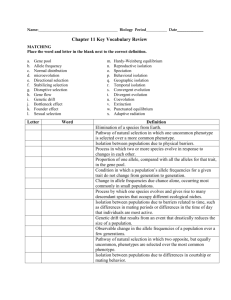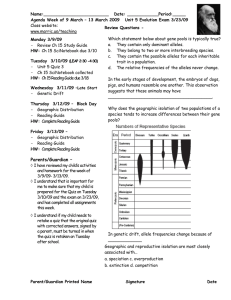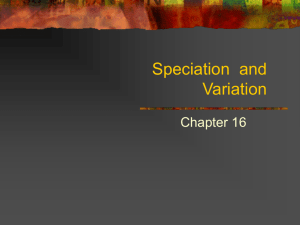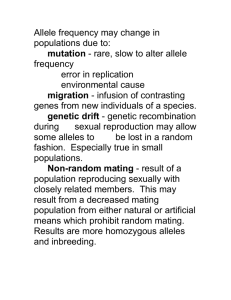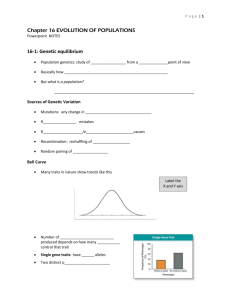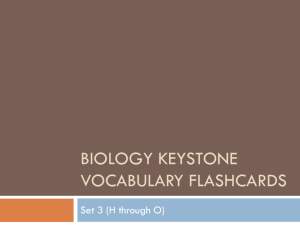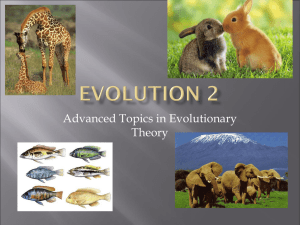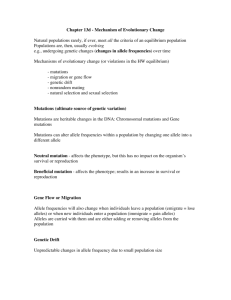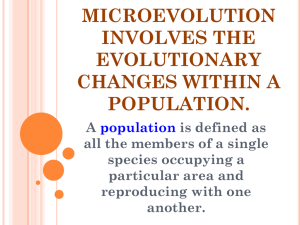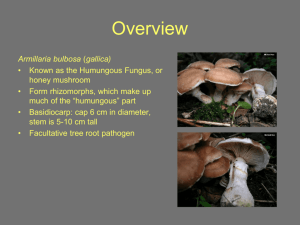3 MECHANISMS OF EVOLUTION and patterns of selection
advertisement
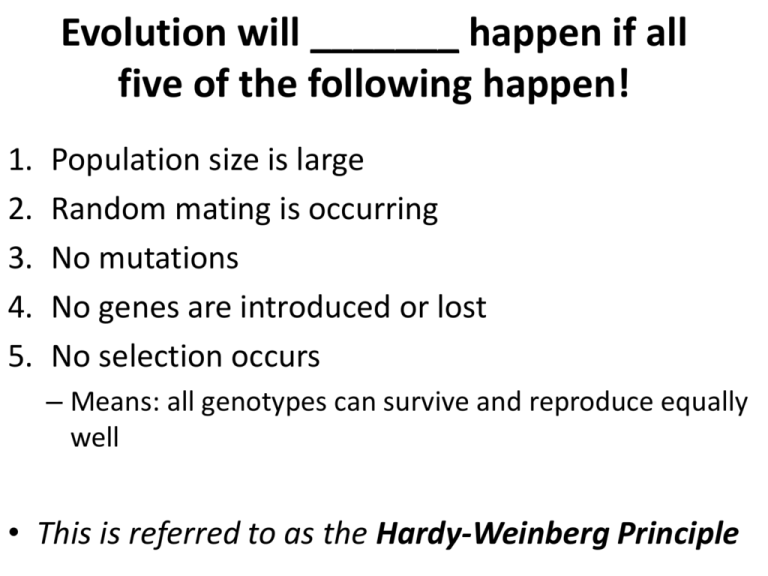
Evolution will _______ happen if all five of the following happen! 1. 2. 3. 4. 5. Population size is large Random mating is occurring No mutations No genes are introduced or lost No selection occurs – Means: all genotypes can survive and reproduce equally well • This is referred to as the Hardy-Weinberg Principle _________________ • rates are generally so low they have little effect on proportions of common alleles • are randomly occurring changes in the DNA sequence of a cell within an organism ___________________ •Frequencies of particular alleles may change by chance alone Important in small populations (e.g.; grizzly bears may be experiencing genetic drift due to isolated populations) Genetic drift A) __________________: few individuals found new population (small allelic pool) Genetic drift B) ___________________: drastic population decrease, and gene pool size Genetic Drift - Bottleneck Effect 15 Genetic drift What type is this? a) Founder or b) Bottleneck? Which graph shows the allele frequency of a larger population? How are they different? • ___________ total of all alleles within a population • _________________ frequency: the proportion of gene pairs (homozygous dominant, homozygous recessive, or heterozygous) in a population. Example: TT:Tt:tt • _________________ frequency: the proportion of gene copies in a population of a given allele. • Example T:t Heterozygote Advantage • Heterozygote advantage will favor heterozygotes, and maintain both alleles instead of removing less successful alleles from a population. – Sickle cell anemia Homozygotes exhibit severe anemia, have abnormal blood cells, and usually die before reproductive age. Heterozygotes are less susceptible to malaria. 21 Sickle Cell and Malaria 22 The term “____________”, when applied to DNA sequences… • Refers to a gene that has only a single type of allele. ____________ the movement of alleles from one population to another _____________________ • Individuals with certain characteristics sometimes mate with each other more frequently than by chance • (e.g., dark and light wolves rarely reproduce in a pack). ____________________________ • When natural selection acts to remove the characteristics that differ from the most common • • • • all zebra have similar stripes Birth weight in humans (and other species) Number of eggs laid by a bird Body diameter of a snake species __________________________ When natural selection acts to remove the characteristics that differ at one extreme from the most common • average height and taller giraffes are selected for, but short giraffes are selected against • Large brains and reduced body hair in humans • Long noses and large size in elephants • Reduced size of salmon due to overfishing ___________________________ When natural selection acts to remove the most common characteristics, leaving the extremes as separate species. • during an extended drought in the Galapagos Islands, the ground finches with medium-sized beaks almost became extinct, leaving separate populations with large beaks and small beaks. • Bill size in African seedeaters, Darwin’s finches, British Columbia stickleback fishes Forms of Selection • • • Disruptive selection – Selection eliminates intermediate types. Directional selection – Selection eliminates one extreme from a phenotypic array. Stabilizing selection – Selection acts to eliminate both extremes from an array of phenotypes. 23 _________________ isolating mechanisms • These mechanisms prevent fertilization directly or indirectly by preventing mating • Preventing mating can occur by: – Ecological (Geographical) isolation – Temporal isolation – Behavioral isolation • Preventing fertilization can occur by: – Mechanical isolation – Gametic isolation (DNA incompatibilities) _____________ ____________ Live in separate habitat or niche ___________________________ • Species that may be compatible may remain isolated because they mate or flower at different times. • For example, the geographic ranges of the western spotted skunk and the eastern spotted skunk overlap but they do not interbreed because the former mates in late summer and the latter in late winter. __________________________ • Distinctive mating rituals in one species will not be recognized by another. The signals for attracting a mate are very specific. • Eg. Frigates _____________________ • Structural differences in reproductive organs prevent copulation. (The parts don’t fit!) • Bush babies, a group of small arboreal primates, are divided into several species based on mechanical isolation. Each species has distinctly shaped genitalia that, like locks and keys, only fit with the genitalia of its own species. _____________________ • Prevents fertilization at the molecular level. • In the event that sperm from another species reaches the egg, it fails to fuse. • Often occurs because the female immune system recognizes sperm as foreign and attacks it. • In other cases, the sperm or pollen may not be adapted to the environment of the female reproductive track. ________________________Isolating Mechanisms • In some cases, mating and fertilization between different, but related, species can occur. • However, if the offspring are not fertile or viable, then the two species continue to be considered as different. • Mechanisms: – Zygotic mortality – Hybrid inviability – Hybrid infertility ________________________ • In this case, the fertilized zygotes or embryos die before birth. • Usually, the chromosomes are not compatible. ________________________ • The embryo develops and is born, but the hybrid is weak, and experiences reduced survival. • It will not survive to reproduce _____________________ • A mule is the result of mating a horse and a donkey. The mule has characteristics of both species but is sterile. Since it cannot breed, it is not considered a separate species but rather a hybrid. Postzygotic mechanisms
